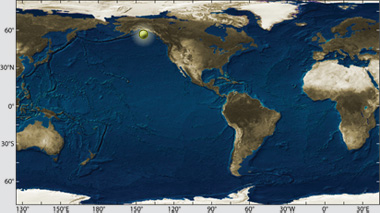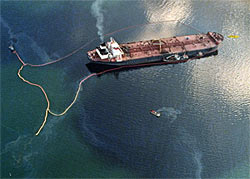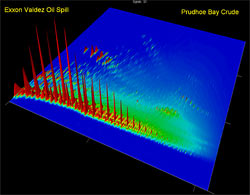Please note: You are viewing
the unstyled version of this website. Either your browser does not support CSS
(cascading style sheets) or it has been disabled. Skip
navigation.

Location: Prince William Sound, Alaska Material spilled: North Slope crude oil Amount spilled: 10.8 million gallons Spill extent: 1,300 miles of coastline Many factors complicated the cleanup efforts following the spill. The size of the spill and its remote location, accessible only by helicopter and boat, made government and industry efforts difficult and tested existing plans for dealing with such an event. Officials employed a variety of countermeasures to control the slick, including burns and dispersants, as well as high-pressure washing on areas of oiled shoreline. Today, most signs of the spill are gone from sight, but research into the long-term biological impacts of the oil has shown that many organisms in Prince William Sound continue to show effects. PublicationsJewett, SC and JJ Stegeman, et al., “Exposure to hydrocarbons 10 years after the Exxon Valdez oil spill: evidence from cytochrome P4501A expression and biliary FACs in nearshore demersal fishes,” Marine Environmental Research 54(2002): 21-48Trust, KA and Stegeman, et al., “Cytochrome P450 1A induction in sea ducks inhabiting nearshore areas of Prince William Sound, Alaska,” Marine Pollution Bulletin 40(2000): 397-403. Marty, GD and JJ Stegeman, et al., “Ascites, premature emergence, increased gonadal cell apoptosis, and cytochrome P4501A induction in pink salmon larvae continuously exposed to oil-contaminated gravel during development,” Canadian Journal of Zoology-Revue Canadienne de Zoologie 75(1997): 989-1007. Woodin, BR; RM Smolowitz, and JJ Stegeman, “Induction of cytochrome P4501A in the intertidal fish Anoplarchus purpurescens by Prudhoe Bay crude oil and environmental induction in fish from Prince William Sound,” Environmental Science & Technology 31(1997): 1198-1205. OpinionLet's not forget Exxon ValdezMarch 24, 2009 editorial by WHOI researcher Christopher Reddy Boston Globe Testimonies & Briefings June 15, 2010
June 15, 2010Oversight Hearing on “Ocean Science and Data Limits in a Time of Crisis: Do NOAA and the Fish and Wildlife Service (FWS) have the Resources to Respond?" Christopher M. Reddy, Ph.D., Associate Scientist, Marine Chemistry & Geochemistry, Woods Hole Oceanographic Institution Last updated: July 28, 2014 | |||||||||||
Copyright ©2007 Woods Hole Oceanographic Institution, All Rights Reserved, Privacy Policy. | |||||||||||



